Silk is one of the most luxurious and coveted fabrics due to its soft texture, beautiful drape, and shimmering appearance.
However, its delicate nature also makes it prone to damage if not cared for properly.
Washing silk incorrectly can cause shrinking, fading, yellowing, and even rips and tears.
That’s why it’s crucial to understand the unique properties of silk and follow specialized care methods when cleaning silk items.
This ultimate guide provides step-by-step instructions, expert tips, and practical advice for safely washing silk at home to preserve its beauty and longevity.

Understanding Silk’s Delicate Nature
Silk is made from the fiber secreted by silkworms when they spin their cocoons. This natural protein fiber is extremely fine, smooth, and lustrous.
However, it is also susceptible to damage from abrasion, heat, moisture, light and improper handling.
The consequences of incorrect washing techniques include:
- Shrinkage – Silk fibers contract when agitated and exposed to high heat during washing, resulting in up to 10-15% shrinkage.
- Color bleeding – The dyes used to color silk often contain loose bonding agents that will bleed and run when washed, leading to color transfer.
- Loss of sheen – Improper washing can remove the special sericin coating on silk that gives it a shimmering appearance.
- Snagging – Silk easily catches on rough surfaces, seams, and embroidery during washing, causing pulls and snags.
- Weakened fibers – Aggressive treatment leads silk fibers to fray and break down more quickly over time.
- Permanent stains – Silk is prone to water spots, grease stains, color transfers, and yellowing if not pretreated and washed carefully.
- Wear and tear – Harsh handling, wringing, and twisting silk when wet can cause irreparable damage.

Preparing Silk for Washing
Follow these preliminary steps before washing your silk items:
- Check the care label – Most silk clothing will have specific washing instructions you should follow.
- Separate colors – Wash dark, bright, and deeply colored silk fabrics separately from light and delicately colored ones to prevent dye transfer.
- Sort items by type – Wash heavier silks like jacquard separately from lighter silks like chiffon to prevent damage.
- Pretreat stains – Use a bit of mild detergent, vinegar, or diluted hydrogen peroxide on grease, food, and other stubborn stains before washing.
- Turn items inside out – This prevents the fabric exterior from abrading against other items in the wash.
- Use mesh bags – Place delicate silks like lingerie and scarves in mesh bags for washing.
- Unbutton closures – This prevents excess strain during washing.

Manual Silk Washing Techniques
Hand washing is the recommended cleaning method for most 100% silk items. Follow these steps:
- Fill a sink or tub with cool, clear water and add a small amount of mild, silk-safe detergent. Avoid regular laundry detergent.
- Submerge the silk item and allow it to soak for 3-5 minutes so the detergent can penetrate the fibers. Do not rub, twist, or scrub.
- Drain the water and refill, gently moving the item to release the dirt. Repeat this process until water runs clear.
- Avoid wringing silk when wet, as this can damage fibers. Roll the item in a towel to absorb excess water.
- Lay the silk item flat on a fresh towel and shape it back into its original form as it air dries.









Handle silk very gently throughout this process, taking care not to pull on seams or put undue stress on the fabric. Agitation should be minimal.
I’ve detailed the risks and potential outcomes in my article on the consequences of not hand-washing silk.
Machine Washing Silk Safely
While hand washing is ideal, machine washing silk can be safe if done with caution:
- Use a front-loading washing machine on the delicate or hand-wash cycle. Top loaders are too harsh.
- Wash silk alone or with other delicates like rayon and wool.
- Use cool water and a mild silk detergent. Keep the temperature under 30°C/85°F.
- Choose an extra gentle wash program with minimal agitation. No heavy spinning.
- Use a mesh bag for added protection.
- Lay flat or hang silk to dry. Never tumble dry!


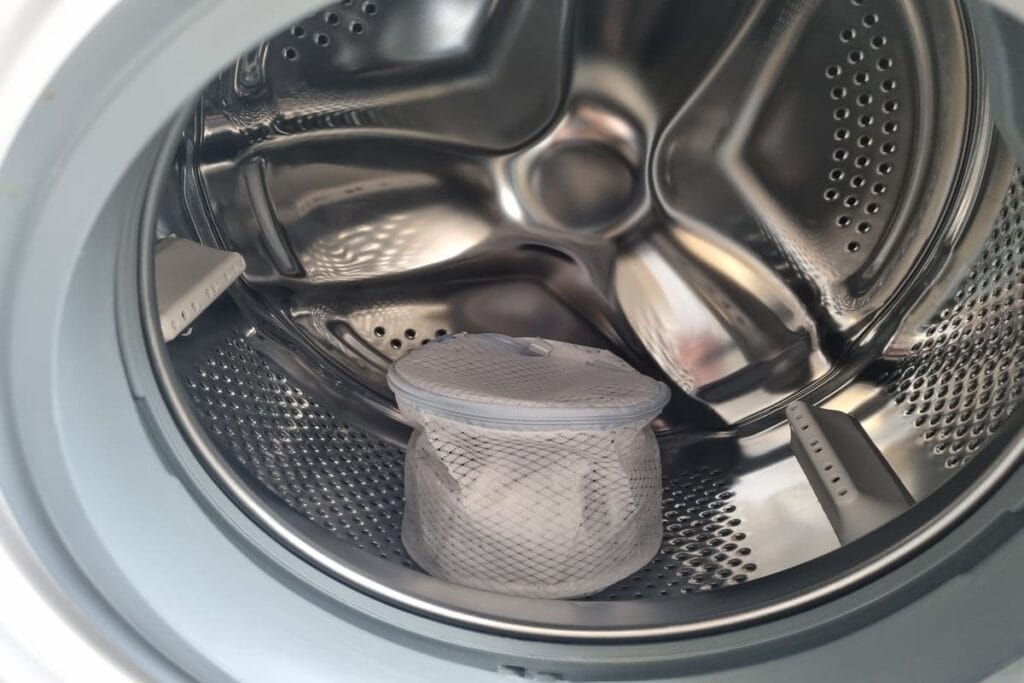

Even with these precautions, machine washing risks rougher treatment that may ruin silk over time. Limit it to sturdier silks.
Temperature and Water Impact on Silk
Proper water temperature is critical when washing silk. Here’s how heat and cold affect silk:
- Water at 60°C/140°F will cause immediate, irreversible damage to silk fibers. Never use hot water above 40°C/105°F.
- Hot water (above 40°C/105°F) causes up to 12% shrinkage in silk and risks setting stains.
- Warm water (30-40°C/85-105°F) may lead to gradual shrinking. Use sparingly.
- Cool water (20-30°C/68-85°F) is the recommended washing temperature for most silk items.
- Cold water (below 20°C/68°F) is fine but may set oily stains without sufficient detergent activation.
- Lukewarm water (25-30°C/77-85°F) provides the best balance for cleaning while preventing damage.
Here’s a concise table summarizing what happens to silk at different temperatures:
| Temperature | Effects on Silk |
| 60°C/140°F | Immediate, irreversible damage |
| 40°C/105°F | Shrinkage, risk of setting stains |
| 30°C/85°F | Gradual shrinking |
| 20-30°C/68-85°F | Recommended washing temperature |
| Below 20°C/68°F | May set oily stains |
In addition:
- Prolonged water exposure can encourage the growth of mildew and bacteria. Keep washing time short.
- Letting silk sit wet causes fibers to stretch and break down. Avoid delay in drying.
- Hard water and chlorinated water can dull silk’s sheen. Use distilled water for rinsing whenever possible.

Silk Drying and Post-Wash Care
Once washed, use these practices to dry and finish caring for your silk:
- Gently squeeze out excess moisture and roll in a towel. Do not wring or twist.
- Lay flat on a thick, absorbent towel to air dry. Shape back into form.
- Use a garment steamer to get rid of wrinkles or creases after drying. Avoid ironing.
- Add a few drops of silk conditioner or fabric softener in the rinse water to restore softness and sheen.
- For frizzy or stiffened silk, use a silk finishing spray.
- Mend any snags, pulls, or holes immediately to avoid bigger damage when washing again.
- Store properly folded or hung silk in breathable garment bags.

Never tumble dry, bleach, iron on high heat, or dry clean silk unless the label explicitly instructs it. Heat and harsh chemicals will ruin silk.
Best Silk Washing Products
Silk-Specific Laundry Detergents
For best results, look for a detergent made just for washing silk fabrics. Here are some top options:
- Heritage Park Laundry Detergent (link to Amazon) – My personal favorite! Cleans gently without fading colors or damaging fibers. Leaves silk soft and bright.
- Slip Gentle Silk Wash (link to Amazon) – Contains silk proteins to help condition fibers. Gets rid of odors without harsh chemicals.
- Woolite Delicates (link to Amazon) – Ultra-mild detergent designed for silk, wool, and other delicates. Retains vibrancy of fabrics.
- The Laundress Delicate Wash – A plant-based formula with a fresh citrus scent. Rinses cleanly without residue.
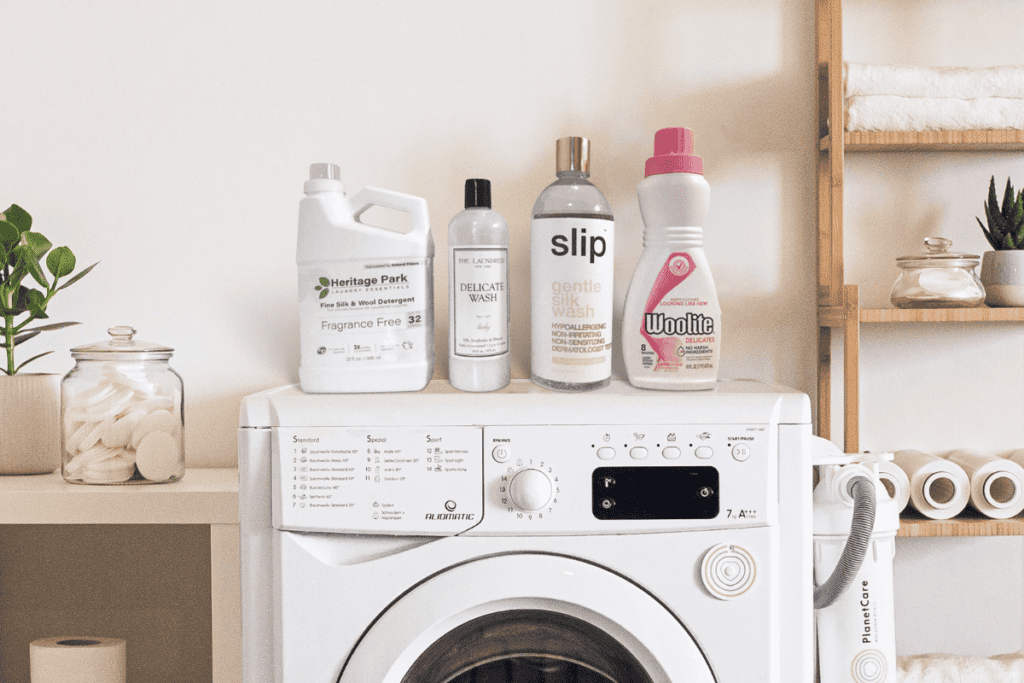
Here’s a comparison table of the different silk detergents:
| Detergent | Key Features |
| Heritage Park | Gentle clean, no fading, leaves silk soft |
| The Laundress | Ultra-mild retains vibrancy |
| Slip | Plant-based, citrus-scented, residue-free |
| Woolite Delicates | Ultra-mild, retains vibrancy |
When it comes to keeping your silk looking its best, specialized detergents designed just for silk fabrics are the way to go.
They out-perform regular detergents while still being gentle on delicate silk items.
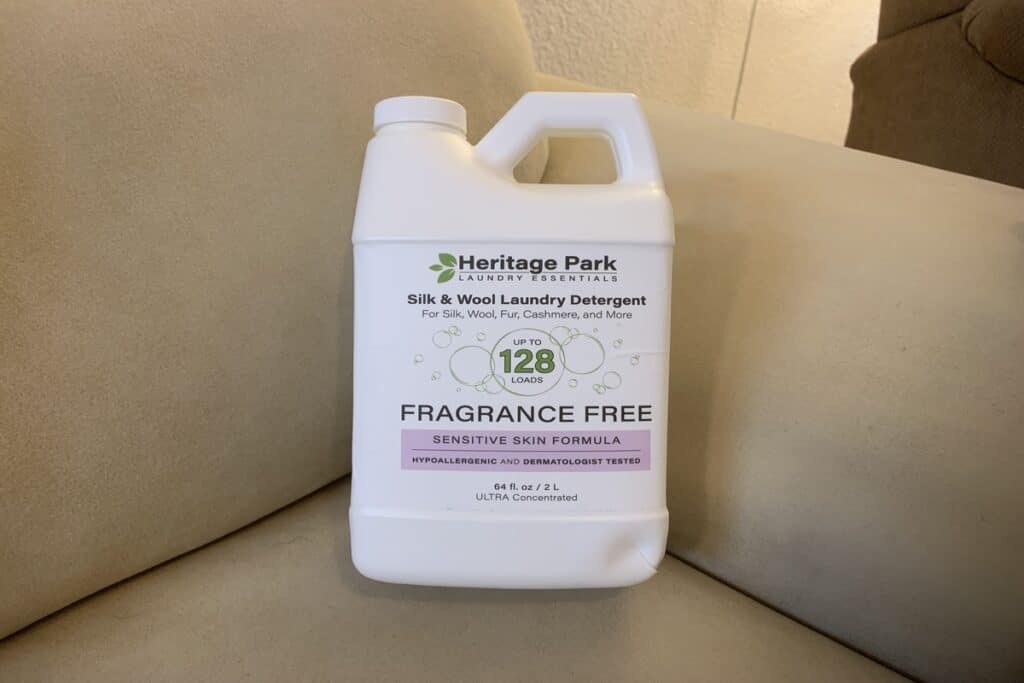
Natural Ways to Clean Silk
When it comes to keeping your silk items looking their best, you’ll want to consider natural cleaning solutions whenever possible.
Here are some gentle silk-washing tips:
- White vinegar – Fill a spray bottle with equal parts white vinegar and water. Lightly mist the garments and let sit for 5-10 minutes before rinsing. The vinegar helps remove odors from silk and brightens its colors.
- Baking soda – Create a paste by mixing 3 parts water to 1 part baking soda. Gently rub the baking soda paste onto stained areas of silk and let sit for a few minutes before rinsing. The abrasive texture helps lift stains without damaging the fabric.




Shampoos for Washing Silk
When looking for a silk-friendly shampoo, avoid ones with sulfates, alcohol, and other harsh cleansing agents. Here are some gentler shampoo options:
- Baby shampoo – The mild formula and pH balance make it a good silk wash. Dilute with water and use sparingly.
- Wool wash – Shampoos for wool fabrics also work well for silk. Try one without lanolin or oils.
- Castile soap – All-natural liquid Castile soap makes a great silk shampoo alternative. Dilute with water before use.
Avoid regular shampoos which can contain sulfates and alcohols that could damage silk fibers and cause them to dry out.
Stick to gentle, chemical-free cleansers to safely wash your silk items. Test any new shampoo on an inconspicuous area first.

Safe vs. Unsafe Products
I tested out some popular laundry products to see if they can be safely used on delicate silks. Here’s what I found:
| Product | Silk-Safe? | Why? |
| Dawn | No | Dish soaps like Dawn are too harsh for silk. The degreasers strip the natural oils, leading to dryness and damage. |
| Bleach | No | Can cause yellowing, weaken fibers, and strip color from silk. |
| OxiClean | No | The abrasives in OxiClean can damage silk fibers and cause pilling. |
| Tide | No | Tide contains optical brighteners, dyes, and other additives that may discolor or degrade silk over time. |
| Woolite Delicates | Yes | Specifically formulated for delicates like silk. Gentle on fabrics. |

Special Considerations for Different Silk Items
Certain silk products require customized washing methods:
| Silk Item | Care Tips |
| Blouse | Wash silk blouses by hand or use a mesh bag, low spin speed. Iron inside out on low when still slightly damp. |
| Sheets | Wash silk sheets by hand or delicate cycle, and cool water. Line dry then lightly iron inside out. |
| Pillowcase | Check label, and dry clean silk pillowcases if needed. Use mesh bag on delicate cycle, no softener. |
| Blanket | Hand washes silk blankets only using Woolite and cool water. Lay flat to air dry away from sunlight. |
| Duvet | Spot clean silk duvet gently by hand, or dry clean according to label instructions. |
| Top | Hand wash light silk tops separately from heavier items. Dry flat on a towel. |
| Comforter | Dry cleaning is often recommended. If washing silk comforters at home, use professional service with large machine. |
| Pants | Turn silk pants inside out, hand wash gently in cool water using mild detergent. |
| Jacket | Check the label first, as dry cleaning is recommended for most silk jackets. If washing, hand wash only. |
| Gown | Dry clean or gently hand wash silk gowns to prevent the risk of damage from beads, embroidery, etc. |
| Saree | Hand wash silk sarees one color at a time, supporting heavy fabrics. Roll in a towel and dry flat. |
| Gloves | Most should be dry-cleaned. If washing, hand wash silk gloves gently in cold water. |
| Tie | Spot clean silk ties by dabbing stains with soap and water. Or dry clean. |
| Scrunchies | Wash silk scrunchies by hand with cool water and delicate soap. Reshape while drying. |
| Bonnet | Turn silk bonnets inside out and hand wash only using a mild detergent, air dry. |
| Face Mask | It’s best to hand-wash silk face masks using gentle baby shampoo. Reshape while drying. |
| Eye Mask | Hand wash silk eye masks only, reshape while drying. Tumble drying can ruin the shape. |
| Curtain | Dry clean only silk curtains to prevent the risk of shrinking or dye transfer. |
| Carpet | Silk carpets can be hand washed but are best professionally cleaned. Vacuum regularly. |
| Flowers | Spot clean silk flowers gently with mild soap and water. Do not fully immerse. |
| Shirt | Turn silk shirts inside out and hand wash in cool water with a gentle detergent. Reshape while drying. |
| Pajama | Hand wash silk pajamas separately in cool water using a mild soap. Dry flat away from direct sunlight. |
| Skirt | Delicately hand wash silk skirts one at a time, reshaping while drying. Iron inside out at a low temperature. |
| Wedding Dress | Dry clean silk wedding dresses to prevent any risk of damage or shrinking from hand washing. |
| Scarf | Gently hand wash silk scarves separately in cool water with a mild detergent. Roll in a towel to dry flat. |
| Dress | Dry clean silk dresses or hand wash by themselves inside out using Woolite and cool water. Dry flat away from heat. |

Other Considerations:
When washing different types of silk fabrics, each requires specialized care as outlined below:
| Silk Fabric | Care Tips |
| Silk Cotton | Machine wash silk cotton cool on a delicate cycle using mild detergent. Air dry and iron inside out while slightly damp. |
| Silk Cashmere | Hand wash silk cashmere gently in cool water using cashmere shampoo. Reshape while drying flat. |
| Silk Chiffon | Hand wash silk chiffon only using extreme care, and lay flat on towels to dry. Do not hang or twist chiffon when wet. |
| Silk Polyester | Machine wash silk polyester on a gentle cycle with mild detergent. Tumble dry low and remove promptly to avoid wrinkles. |
| Silk Linen | Hand wash silk linen or use a mesh bag on a delicate cycle. Rinse well and line dry, iron inside out on low heat. |
| Silk Velvet | Dry cleaning is often recommended. If hand washing silk velvet, use gentle detergent and reshape while drying. |
| Silk Satin | Hand wash the silk satin in cool water with a gentle detergent made for delicates. Rinse thoroughly, roll in a towel to remove excess moisture, and lay flat to dry. |
| Mulberry Silk | Hand wash mulberry silk in cool water using delicate soap. Roll in a towel to dry, iron inside out on low heat. |
Always check garment tags since these are general guidelines. Test wash silks in an inconspicuous area first.
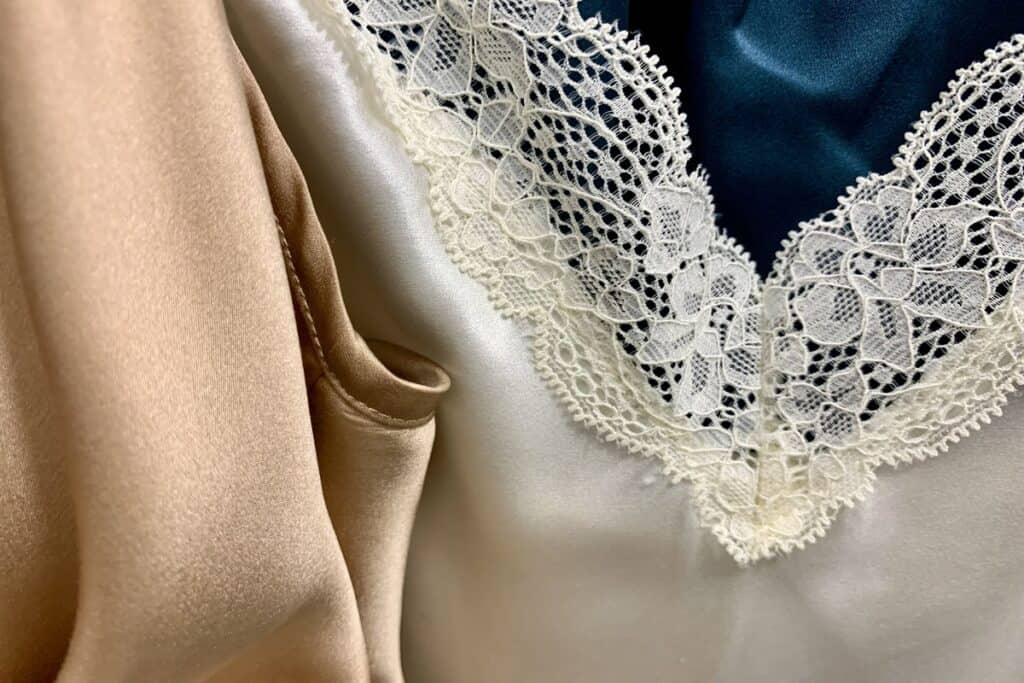
Stain and Odor Removal from Silk
Treat stains on silk as soon as possible using these natural, safe methods:
Food Stains
- For minor stains, gently dab with mild soap and cool water. Rinse thoroughly.
- For tougher stains, apply diluted white vinegar or lemon juice. Let sit briefly before washing as normal. The acid helps break down the stain.
Coffee Stains
- Blot immediately with a clean, absorbent cloth to soak up excess coffee. Avoid rubbing or pressing stains further into the fabric.
- Mix a solution of lukewarm water and vinegar. Dip a cloth into the solution and gently dab the stain. Vinegar helps neutralize coffee acids over time.

Tea Stains
- Apply glycerin to fresh stains and let sit for 1 hour. The glycerin draws out stain particles from protein-based silk fibers.
- For set-in stains, make a baking soda paste with just enough water to form a paste. Gently rub the paste onto the stain with a soft cloth or an old toothbrush. Baking soda extracts stubborn tannin tea stains from silk.

Water Stains
- Dissolve an aspirin tablet in hot water, then dip a soft cloth into the solution. Gently dab the aspirin water onto the stain – the aspirin helps lift discoloration.
- Make a 50/50 mixture of lemon juice and water. Using a clean sponge, lightly tamp the citric solution onto the stain. The acids in lemon lift and brighten dingy water marks on delicate silk.

Grease and Oil Stains
- Gently brush off the powder. You may need to repeat this process several times for stubborn oil stains. The powder will draw out the grease.
- Dish soap can also help cut through oily stains from silk. Dab a bit of diluted dish soap on the stain and work into the fabric. Rinse thoroughly.
- For tougher oil stains, try blotting with hydrogen peroxide before washing as normal.
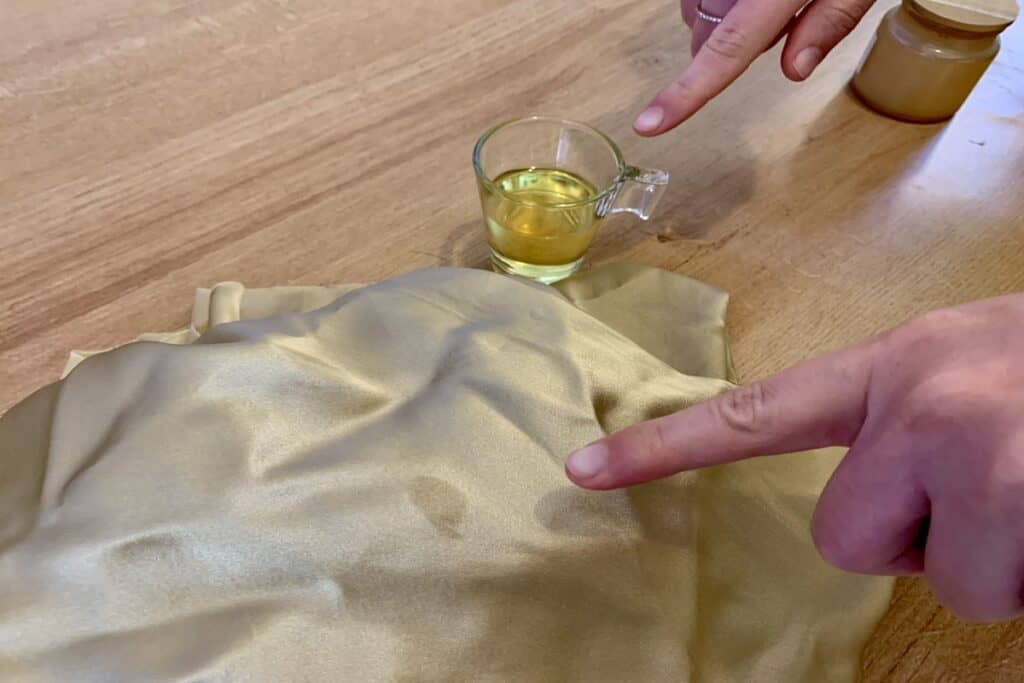
Sweat and Deodorant Stains
- Make a paste of baking soda and water. Rub it gently into the stained area and let sit for 20 minutes before washing.
- White vinegar also helps remove odors and stains. Spray it on and let soak in before washing.
Mold or Mildew Stains
- Treat mildew stains quickly – they can damage silk permanently over time.
- Make a solution of diluted lemon juice or hydrogen peroxide. Apply it to the stain and let sit in the sun to bleach and sanitize.
- For serious mildew, use a sulfur bleach designed for delicates and silk. This will remove the stain without damaging the fabric.
Mothball Stains
- Blot the stain repeatedly with hydrogen peroxide or lemon juice to lift it.
- After treating, wash the silk item by hand in very hot water to eliminate any mothball odor. Air dry in the sun.
Ink or Makeup Stains
- Dab the stain immediately with rubbing alcohol using a clean white cloth, working from the back of the fabric.
- For stubborn makeup stains, break up the pigment with an oil-based makeup remover before washing.
Always spot-test stain treatments first to ensure they don’t damage your silk fabric.
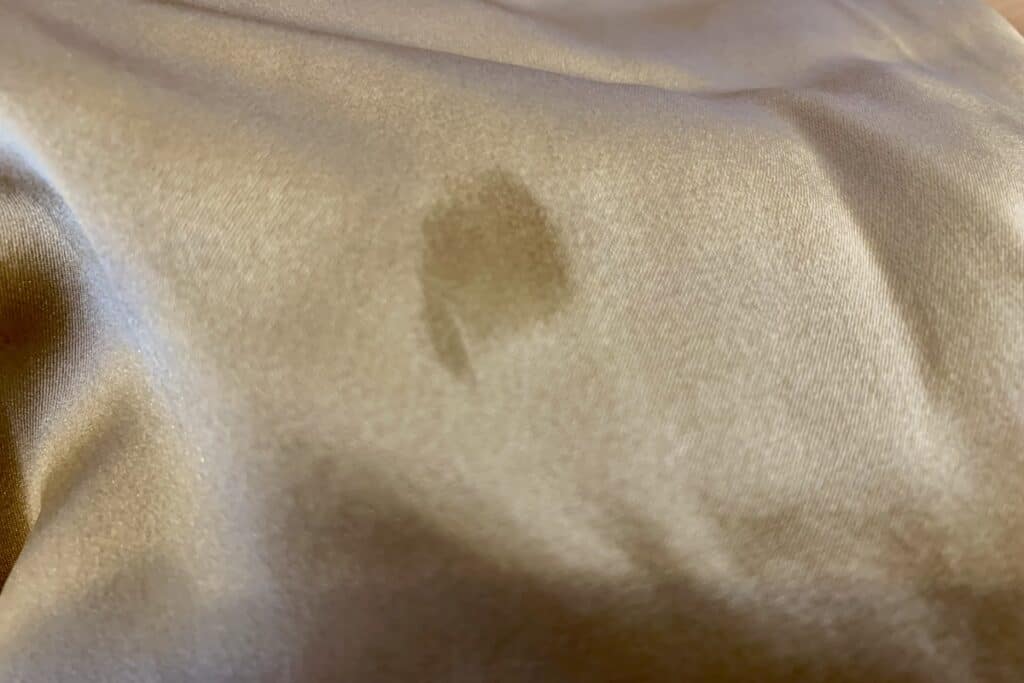
Maintaining Silk’s Longevity
Washing silk too often can cause premature wear and damage. Use these tips:
- Only wash silk when visibly soiled. Air out and steam instead to refresh between washes.
- Lightly worn silks only need 2-3 gentle washes per year. Heavily worn silks may need monthly washing.
- Hand wash silk after 2-3 wears. Machine wash sparingly, every 5-6 wears.
- Spot clean stains in between washes to avoid frequent laundering. Small stains can often be dabbed out.
- Rotate silk items rather than wearing the same one daily. Allowing time between wears reduces the need for cleaning.
- Hang silk items to air out rather than repeatedly washing them. Sunlight also helps deodorize.
Gently washing high-quality silk items every 3-4 months is sufficient in most cases. Regular, gentle care preserves silk best.

Dry Cleaning vs. Home Washing
Many silk garments state “Dry Clean Only” on their labels. However, gentle home washing is still possible in many cases:
- 100% silk items – Most can be hand washed at home using proper techniques. Exceptions include fragile silks prone to snagging and some embellished silks.
- Heavy silks – Shantung, dupioni, damasks, and thick silks can be machine washed on delicate at home unless heavily embroidered.
- Sheer, lightweight silks – Georgette, chiffon, and crepe de chine are too delicate for washing machines. Hand wash only.
- “Dry Clean Only” labels – This is often stated for legal purposes. Try hand washing first in a hidden area.
- One-of-a-kind silks – Heirloom and vintage silk pieces are best dry cleaned to prevent damage from home washing.
- Frequent washing need – Dry cleaning is gentler for delicates that need very frequent cleaning.
Use your best judgement based on the silk item’s construction, age, and wash frequency needs. When in doubt, opt for professional dry cleaning.
In my exploration of silk care, I address the implications of skipping dry cleaning for silk in this informative piece.

Preventing Common Silk Washing Mistakes
Avoid these all-too-common errors when laundering your silk:
- Washing silk in hot water, leading to shrinkage, dye bleed, and damage. Always use cool water.
- Using regular laundry detergent, which is too harsh. Opt for mild silk soaps instead.
- Mixing silk with other fabrics, causing snags from zippers, buttons, etc.
- Agitating and wringing silk when wet, which stresses fibers. Handle minimally.
- Putting silk in the dryer can shrink and crease it. Always line dry silk!
- Ironing silk on the highest heat setting, which can scorch it. Use medium heat with a press cloth.
- Soaking silk too long, allowing mildew and bacteria growth.
- Letting stains sit on silk, causing a permanent set. Pretreat stains ASAP.
- Waiting too long between washes, results in the buildup of dirt, oil, and debris that becomes harder to remove.

Fixing Washing Mishaps with Silk
Silk is a delicate fabric that can easily be damaged if washed improperly.
Don’t worry if you’ve accidentally shrunk your silk or made it look dull – there are some tricks you can try to fix your silk clothing or accessories.
How to Unshrink Silk
Silk shrinks when the fibers are distorted in water that is too hot or by improper agitation during washing and drying.
Thankfully, there are some straightforward steps to reverse the shrinking of silk:
- Fill a basin with lukewarm water and add a small amount of hair conditioner, which will act as a lubricant for the silk fibers. Submerge the shrunk silk item and let it soak for at least 30 minutes so the fibers can relax.
- Drain the water and gently stretch the silk back to its original size, but don’t pull too firmly. Support the edges with your hands while stretching so the silk doesn’t distort.
- Lay the silk item flat between two towels and roll it up to absorb excess moisture. Unroll, reshape and allow to fully air dry before wearing or storing. The conditioner should allow the fibers to move back into place.

Removing Unpleasant Odors from Silk
If your silk has developed an unpleasant scent after washing, don’t panic. This is usually caused by excess moisture being trapped in the fibers. Simply follow these steps:
- Fill a sink or basin with equal parts cool water and white vinegar. Add several drops of essential oil such as lemon, lavender, or mint for freshness.
- Fully submerge the stinky silk item and let soak for 1-2 hours. The vinegar will help rinse out the odor-causing bacteria or mold.
- Remove and gently squeeze out excess liquid – don’t wring or twist aggressively. The essential oil leaves a light, springtime fragrance.
- Lay flat on top of a towel or roll up in a towel to absorb remaining moisture. Reshaping while rolled can help realign fibers.
- Allow to fully air dry then wear or store your sweet-smelling silk! The vinegar soak sanitizes without harsh chemicals that could damage delicate silk.
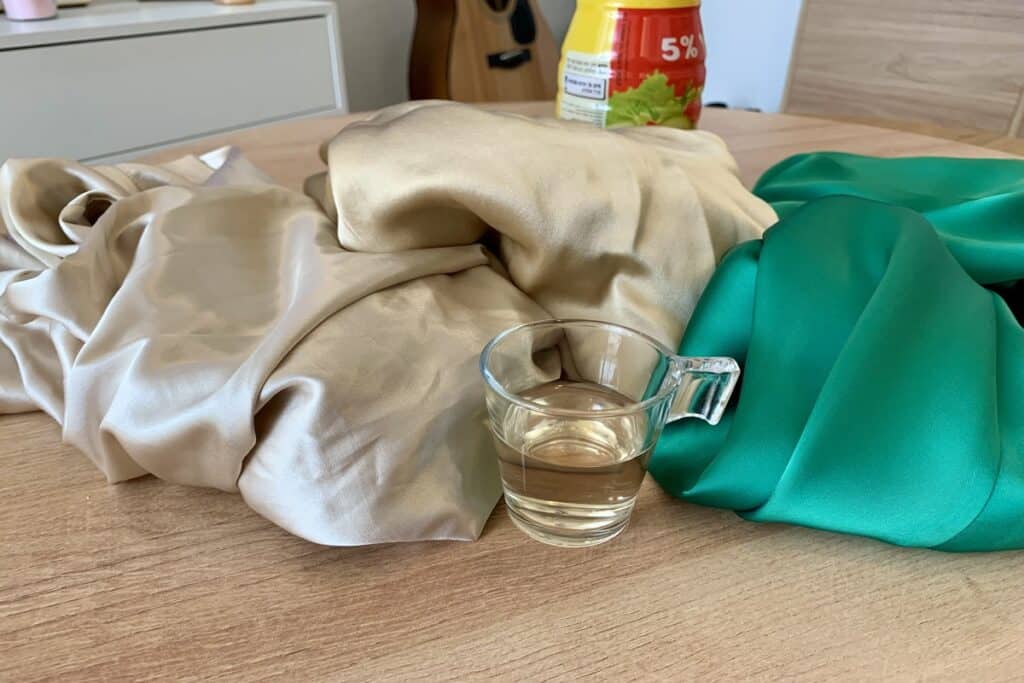
How to Make Silk Shiny Again
Silk loses its natural sheen after washing when the delicate fibers become distorted, preventing them from properly reflecting light. Here’s how you can restore silk’s sheen:
- Hand wash the silk in cool water with a tiny amount of mild soap, using gentle circular motions. Rinse thoroughly.
- Fill a basin with cool water and add a capful of white vinegar, which helps restore the silk’s radiant look. Soak the item for 30 minutes.
- Drain and roll the silk item in a towel to absorb excess moisture. Reshape while still rolled up.
- Lay flat and allow to fully air dry. The vinegar rinse helps the fibers reflect light better, improving the silk’s luminosity.
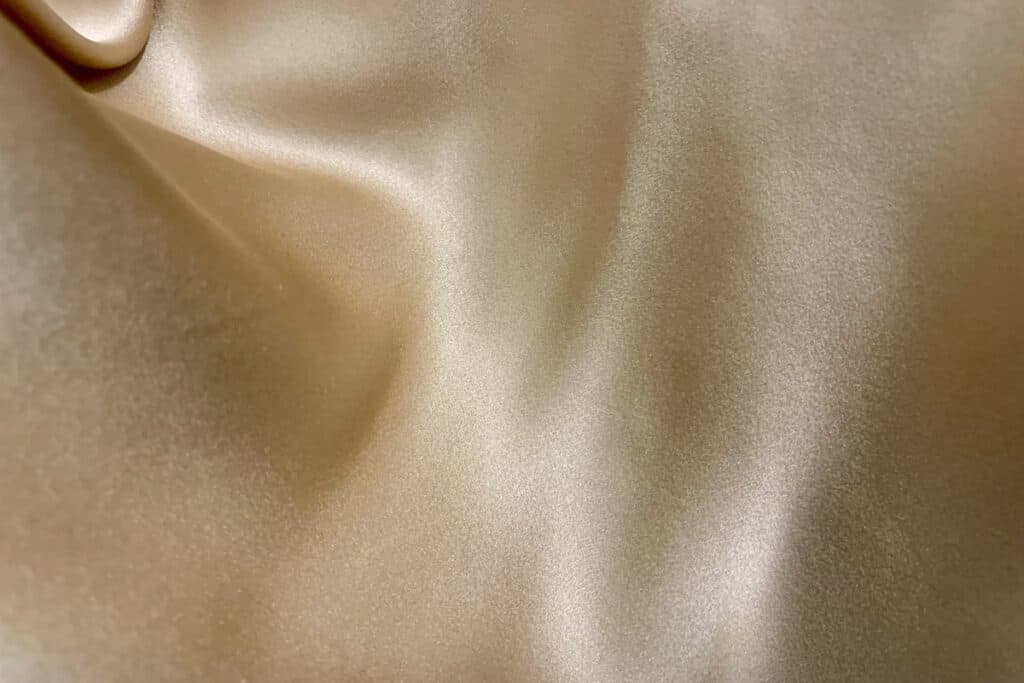
Conclusions
Caring for delicate silk may seem daunting, but taking the proper steps outlined in this guide will keep your silk items looking beautiful wash after wash.
The keys are using cool water, mild detergent, minimal agitation, and air drying. With a gentle approach, even expensive silk stays lovely for the long term.
Follow these tips and you can confidently wash silk bedding, clothing, and accessories at home without damage.
